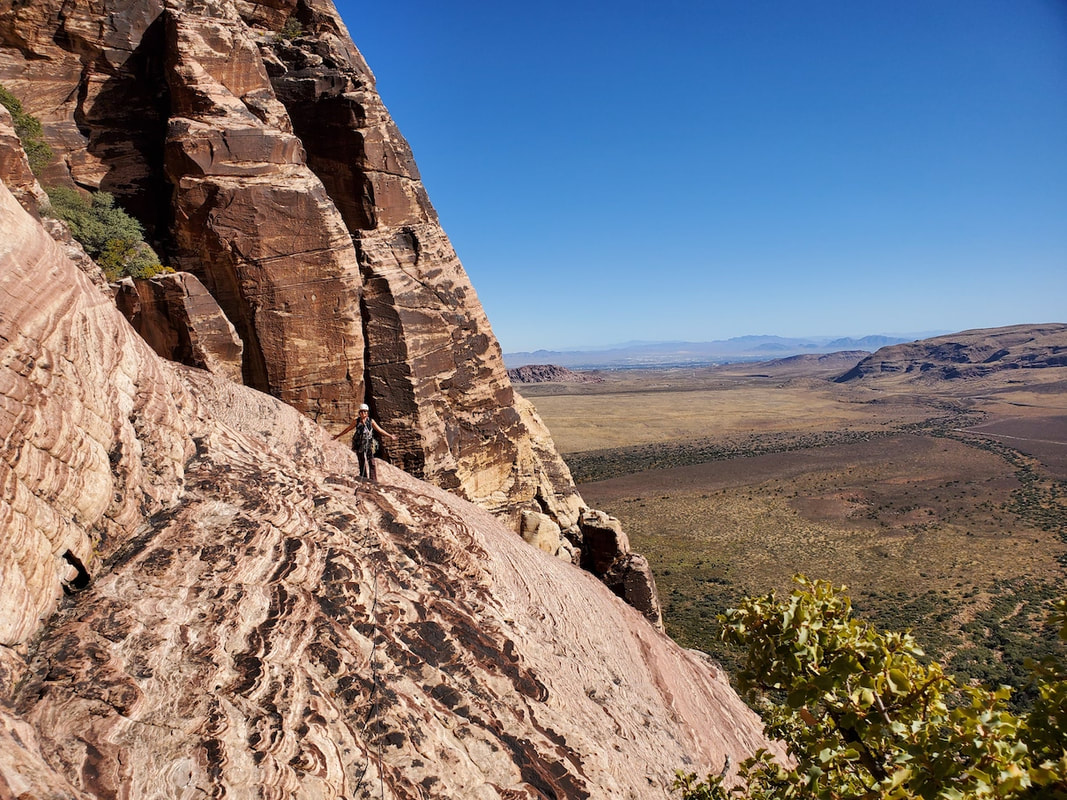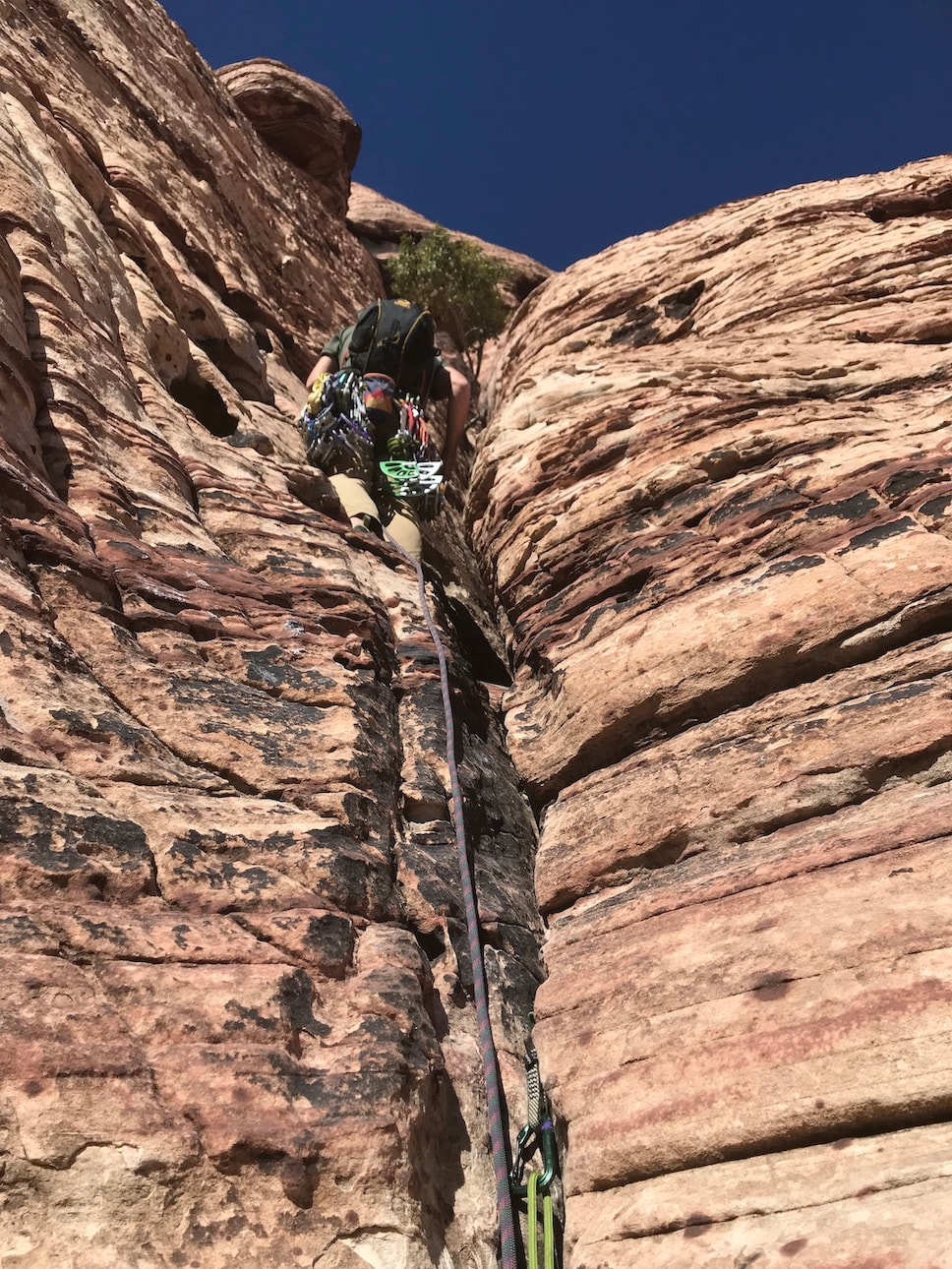SUMMARY HAIKU
What the Fabulous?
Not to Rick, who had bad gas.
What the FLATULENCE
What the Fabulous?
Not to Rick, who had bad gas.
What the FLATULENCE
|
DATE OF CLIMB: October 26, 2019
WALLS HIT: 1 (Jackrabbit Buttress) NUMBER OF CLIMBS: 1 NUMBER OF PITCHES: 7 NUMBER OF FALLS: 0 NUMBER OF TAKES: 0 VERTICAL 5.7 FEET CLIMBED: 1100' TOTAL VERTICAL FEET ON THE TOUR SO FAR: 5,080 NUMBER OF CLIMBS REMAINING: 191 VERTICAL FEET REMAINING: ~45,182 DIRTY UNDERWEAR ENCOUNTERED: 0 DIRTY UNDERWEAR ENCOUNTERED TO DATE: 3 (holding steady at three...) |
START & END TIMES:
|
The Route
Climb: Myster Z (Trad) (1100')
Wall: Jackrabbit Buttress
Conclusion WTF? What the FLATULENCE!
Wall: Jackrabbit Buttress
Conclusion WTF? What the FLATULENCE!
Yes, you read that correctly, we rated the climb "What the Flatulence." Why? Because Rick and I couldn't agree on a rating and his excessive gas was the one commonality we could agree on - haha!
So, the rules of this game are the person who leads gets to ultimately choose the rating, but we swung leads on this climb and we had differing opinions.
So, the rules of this game are the person who leads gets to ultimately choose the rating, but we swung leads on this climb and we had differing opinions.
- I (Stef) LOVED Myster Z! If I could choose the rating I would have called it What the FABULOUS! What the FANTASTIC! Or even What the FAVE! Since this is one of my favorite climbs we've done so far on this tour. Why did I love it?
- Variety - This climb had personality galore - a little bit of this and a little bit of that (face climbing, chimney, stemming, offwidth, slab, a jam here and there, a itty bitty juggy roof, an easy traverse). It was just so damn interesting!
- Decent and beautiful rock - To get up an 1100-foot climb without having some section of it be completely sketchy rock that crumbles beneath your feet or fingers is pretty incredible. Yes, there's fragile stuff here and there, but nothing that threw me into "freakville" while leading (Rick encountered the worst of the rock on Pitch 1 while avoiding the chimney - this did not help his experience.) Plus the rock is varied and freaking gorgeous - scroll to the photos and pay attention to the differences in the rock in each photo.
- There is 5.7 on just about every pitch, some a little spicier than others. If you look at Handren or Mountain Project you'll see differing opinions on which pitch is the crux and which pitch is really 5.7. I felt like there were 5.7 moves on almost every pitch (and each 5.7 skill being different on each pitch). This was mixed in with lower grade material to give you some breathing room.
- The run-out was not as consequential (as say compared to Group Therapy). Yes, there is run out on almost every pitch, some of it quite big (30+ feet or more in spots) - we even brought our number 6 and used it frequently to reduce the runout. But, for some reason the fall zones didn't seem as dangerous (again, nothing that threw me into "freakville.")
- For the most part, I felt like I knew where I was. With 100%-trad climbs (i.e. no bolted anchors) it's easy to get off-route or feel confused as to whether you are really on the climb (again, Group Therapy comes to mind). Although we broke up the pitches a bit differently than the book and the Mountain Project topo and there were a couple of "Huh? Are we at the right spot?" moments, overall I didn't really feel lost or confused or felt thrust into "oh God!" terrain.
- Variety - This climb had personality galore - a little bit of this and a little bit of that (face climbing, chimney, stemming, offwidth, slab, a jam here and there, a itty bitty juggy roof, an easy traverse). It was just so damn interesting!
- Rick, struggled on this climb.
- Rick's experience with Mystery Z might have been different if his head-space wasn't off and his bowels weren't emitting toxic fumes every few minutes (which probably amplified any foggy-head issues). We all know how important the lead-head and physical well being can be to one's experience with the rock!
- With his lead-head off, Rick felt less comfortable with the run-out than I did.
- He also felt challenged by the different climbing skill demands at each pitch (and Rick is a very experienced climber). For example, he confided that stemming, off-width, and chimneying aren't skills he feels he's honed and, as a result, he's not as comfortable leading them over runout (although he did a fantastic job leading the quite challenging run-out choof - chimney-roof-pitch on Group Therapy - yes, Group Therapy will be my comparison test piece for a while - haha!)
- On a side note: There are several comments in Mountain Project about it being a good climb for a newer leader. I'm not so sure that an 1100' climb with big run out is good for any newer leader. Also, the variety of moves needed for this climb might really push a newer leader in some uncomfortable ways.
- Below is a blow-by-blow pitch description - Yes, pun intended, but I'll spare you from the gory details of Rick's pretty hilarious (at least to me) flatulence.
Pitches
|
PITCH 1
(~160 feet, we ended where the Handren Guide & MP Topo decribe a ledge in a chimney) Some people talk about going up the squeeze chimney (located right below Rick in this photo), others talk about going left onto the face to avoid it. Rick puzzled below the tiny chimney for a bit. It wasn't simple to get inside, much less be able to fit into it with a pack on. Instead, Rick went out left onto the face then worked his way back right, easily avoiding the mini-roof. This is one spot where the rock was a bit more fragile. PITCH 2
(~200 feet, I kept climbing until I ran out of rope and could build an anchor, ending well into most of Handren's Pitch 3) This pitch is one that didn't sound anything like the descriptions, so maybe I went the "wrong way." The topo says something about "stepping across to scoop and crack" and then going up a hand crack. I didn't step across anything, nor did I experience a hand crack (although I did jam my hand into crevices here and there...) I just followed that column up (the one you see in the photo) until it lead into an offwidth-chimney-type-thing. It ate up large pro like crazy and then got too big so I ran it out until I reached the tiger striped rock. which didn't really take pro either, so I kept running it out (I think I placed one tricam in a hole in about 60 feet). From my belay spot it was easy terrain over to the next main pitch. Pitch 3
(115 ft) Rick lead this cruiser walking pitch traverse over to Pitch 4 at the base of the next headwall. Pitch 4
(170 ft) The descriptions talk about a "finger crack." When I hear the description "finger crack" I think of a splitter style crack where you dig your fingers into the rock to climb. Unless I missed it, this doesn't really fit my concept of a finger crack. The crack beneath this lip of rock was finger-sized (here and there), opening and closing to occasionally fit smaller gear. Then guess what, it gets wide again (big pro!) At first I (Stef) questioned if I was at the correct location, but this ended at the right spot - a chimney next to a detached pillar with a block on top. |
|
Pitch 5
(~120 feet?) The stemming, small traverse, mini-roof pitch. Stem up this off width past the tree that is right in the middle of your path, go up to a really cool looking big roof and wave bye-bye to it, heading right until you see a crack going up a small 2-step fun juggy mini-roof. The descriptions say something about belaying in a horizonal. We really weren't sure what they were talking about...Rick stopped below a big offwidth - we didn't see a horizontal crack. There was also quite a bit of rope left, so maybe Rick needed to traverse more than he did? Because this pitch ended sooner than we thought, Rick went ahead and lead the next pitch. Pitch 6
(~100 feet) An offwidth crack with stemming, face climbing, and squirming. Rick stopped not far from the topout of this crack where the terrain gets low angle for a bit then starts upwards again. |
|
Pitch 7
(~210 feet) Back and forth between small sections of 5th class (like you see here) and low-angle blocky terrain. I went until I the rope stopped me, then brought Rick up. The terrain is 3rd class after this. Keep going until you see cairns, follow the cairns to Brownstone Wall then down Juniper Canyon for the decent. (NOTE: We did have more water - with electrolytes! - waiting for us down at the base of the climb!)
|














